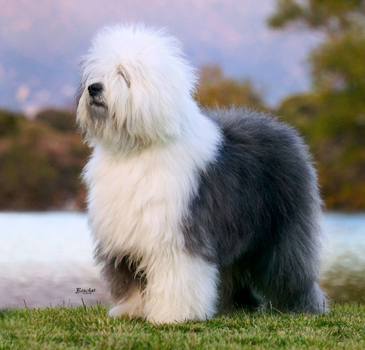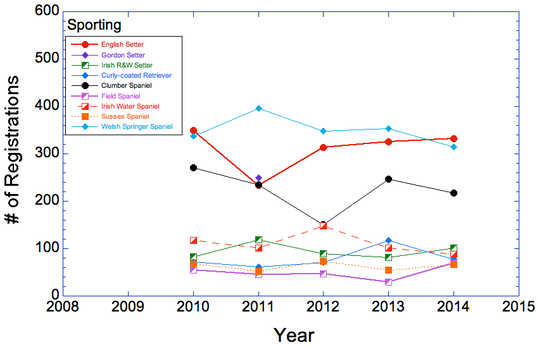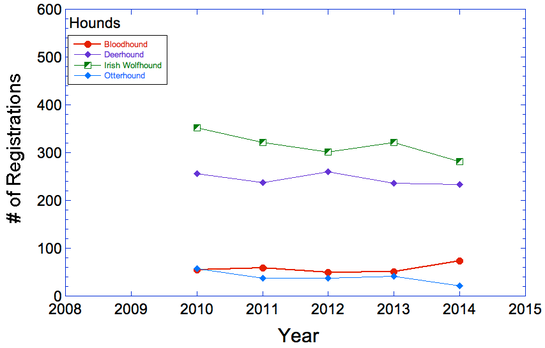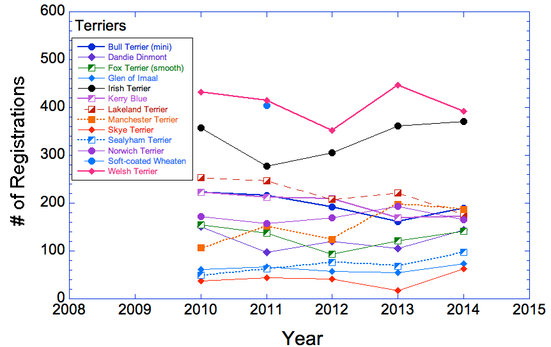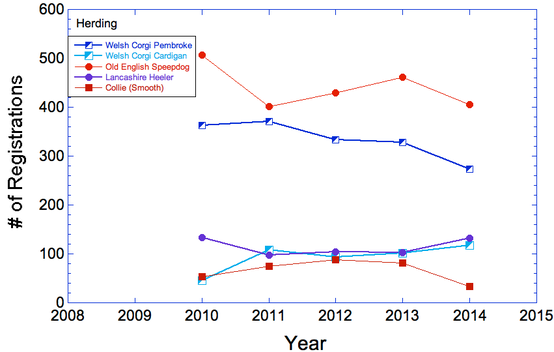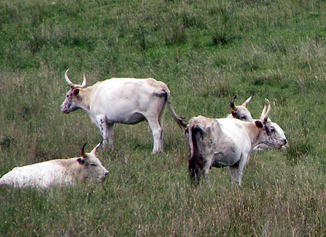| By Carol Beuchat PhD The UK Kennel Club has evaluated the registration statistics of the breeds that are are British or Irish in origin (the "native" breeds) and come up with a list of breeds they consider "vulnerable" or worthing of watching carefully. Of course, the vulnerability they're worried about is extinction. You can view the list at the link, but I've taken some of their data and created a few graphs so it's easier to visualize the information. I've organized them by group and included both the vulnerable and "at watch" breeds. They have selected these particular breeds because of their low registration numbers, which are depicted in these graphs. |
You might have heard of the "50/500 rule", which has for many years been the "rule of thumb" for population sizes in genetically managed populations. To establish a new population, it was thought that the minimum number of animals was 50, and to maintain a sustainably breeding population for 100 generations the minimum population size was estimated at 500.
Here we need to explain the difference between census population size, which is the actual number of animals in the population, and "effective population size", which you can think of as the "genetic" population size. The 50/500 rule is referring to effective population size. What does this mean?
If the numbers of breeding males and females are the same, then effective population size will be the same as the census size. But if the ratio of males to females is not 1:1, then the effective size will be less than the census size. Let's say we have 100 unrelated animals, 50 males and 50 females. If each animal contributes one litter to the next generation and none breeds more than once, their individual genetic contributions will be roughly equal (allowing for some variation in litter) and the offspring will only be related to their litter mates. On the other hand, if we have 99 females and 1 male, again a population size of 100 animals, and each female produces one litter, they will all have to breed to the same male and the entire next generation will be half-sibs.
We can calculate the effective population sizes (Ne) of these two populations using a simple formula:
Ne = (4 x Nm x Nf) / (Nm + Nf)
where Nm and Nf are the number of males and females, respectively, bred per generation or per year.
So, for the first population, we have
Ne = (4 x 50 x 50) / (50 + 50), or Ne = 10,000 / 100; so Ne = 100
Effective population size is 100, equal to the actual number of animals in the population.
Now, for the second population:
Ne = (4 x 1 x 99) / (99+1), or Ne = 396 / 100; so Ne = 3.96
Even though the second population has the same number of animals as the first, the population "behaves" genetically like a population of only 4 animals with a sex ratio of 1:1. How can this be? The first generation will produce a population in which all of the dogs are either full sibs because they are littermates, or half-sibs because they share a sire. Those dogs will all have a COI of 0%, but for the next generation every dog will have to breed either to a full sib or a half sib. Their offspring will have COIs of either 12.5% (half-sib to half-sib) or 25% (full sib to full sib). In two generations, we have gone from 100 unrelated animals to a seriously inbred population. Now you can see the powerful effect of the popular sire
So you see how the 50/500 rule works, but here we need to interject and say that the rule of thumb that has been used by conservation geneticists for the last 40 years or so is now thought to be inadequate. Revised estimates are 100/1,000, or even 500/5,000, at least in part because survival for only 100 generations is not saving a population from extinction. In fact, we really should aim for sustainable breeding in perpetuity, and for this population sizes will need to be higher than the original estimate. The problem is that we can't really do the experiment that would test any of these predictions, so the best we can do is simulations of populations under various scenarios that resemble what might happen to a real population over hundreds or even thousands of generations. The minimum population sizes we should aim for to prevent extinction are the topic of hot debate, some of which you can read here.
While the argument rages, we can at least estimate some effective population sizes for the breeds on the Kennel Club's vulnerable list, just to get an idea of where they stand.
If we assume a litter size of 5, then 100 registrations per year would be about 20 litters. If we assume a different dam for each litter, that would be 20 bitches bred to 20 or fewer sires. We know we can estimate Ne if we know the number of males and females that produce litters from the equation as above:
Ne = (4 x Nm x Nf) / (Nm + Nf)
If the male to female ratio is 1:1 (i.e., 20 males and 20 females), then Ne will be 40. (Do the math and convince yourself that this is true.) This is far below the more recent recommendations of MVP size of 100. For breeds with smaller litters (e.g., 3), the estimate of Ne will be a bit higher, and for breeders with larger litters it will be smaller, but this is a useful ballpark, back-of-the-napkin estimate.
So for breeds like the Lancashire Heeler, Smooth Collie, Cardigan Corgi, and English Toy Terrier in the graphs above, we would expect Ne to be roughly 40. For the Skye, Sealyham, and Glen of Imaal terriers, with registration numbers of 20-50 per year, Ne will be 20 or less. For many of these breeds, the average litter size we're assuming (5) might be on the high size because of inbreeding depression, and if there are males siring more than one litter per year, the true effective population sizes could be in the single digits.
These breeds are indeed vulnerable, but this list only included the UK "native" breeds. How long would the list be if it included ALL the breeds with Ne less than 100? How long would the list be for breeds with Ne less than 1,000, which is thought to be the minimum necessary for long term sustainability?
The age-old maxim of "only breed the best to the best" takes on new meaning when you look at these figures. We are managing quality of offspring through selective breeding (both in terms of type and health), but we are not managing the size and health of the gene pool. To meet the minimum requirement of Ne = 100, we would need at least 50 bitches bred every year, and more than that if there were fewer than 50 sires. In fact, the maxim needs to be something like "breed at least 50 of the best females and 50 of the best males in each generation", and if we allow for some dogs siring multiple litters, it might be more reasonable as "breed at least 200 of the best females." You would still chose to breed the best to the best where you can, but you would also need to breed many dogs that are not "best" quality but just "good enough", and many of their offspring would need to go on and breed as well.
This would be a sea change in the way dogs have been bred for the last 100+ years, but it has to happen or many breeds are likely to collapse from inbreeding depression, excessive numbers of genetic disorders, and loss of alleles through genetic drift. These things are predictable from first principles of genetics, and decades of study of animal populations, both wild and domestic, support this scenario.
| Somebody is going to protest - "But what about the Chillingham cattle?" If you're unfamiliar, this is a herd of wild cattle that has been isolated in a park in northern England for hundreds of years, perhaps back to the 13th century. The reason this herd is famous is because they have managed to remain viable for so long despite being a closed population, beating the predictions of extinction from inbreeding and disease. The population has apparently been purged of most deleterious alleles because inbreeding accumulated very slowing, allowing less fit animals to be culled by natural selection without seriously compromising the size of the population. So, it is possible, if the circumstances are just right, for a population of animals to persist despite severe inbreeding, but the examples of success are extremely rare and countless deliberate attempts to maintain closed, inbred populations indefinitely have failed. |
Remember, the revised 50/500 rule is now felt to be too low, and newer recommendations are 100/1,000 or even 500/5,000, where the larger number is the size required for a sustainably breeding population that is expected to persist for centuries. For many dog breeds, these numbers will be impossible to meet, and for them we will need to adopt breeding strategies specifically designed to control inbreeding and minimize loss of alleles through genetic drift. Or we should consider the better alternative: convince kennel clubs to open the stud books so that dog breeding can return to the way it was practiced for thousands of years, with the occasional injection of new genes to reduce inbreeding depression and to improve the traits that need it.
How big is your breed?
-------
Errata: The original version of this article had an error, stating that a population of 99 females and 1 male had an effective population size of 40, which is incorrect. The correct effective population size would be 4.
-------
Visscher PM, D Smith, SJG Hall, & JL Williams. 2001. A viable herd of genetically uniform cattle. Nature 409: 303 (doi:10.1038/35053160)
Hall SJG and JG Hall. 1988. Inbreeding and population dynamics of the Chillingham cattle (Bos taurus). J. Zoology 216: 479-493. (DOI: 10.1111/j.1469-7998.1988.tb02444.x)
